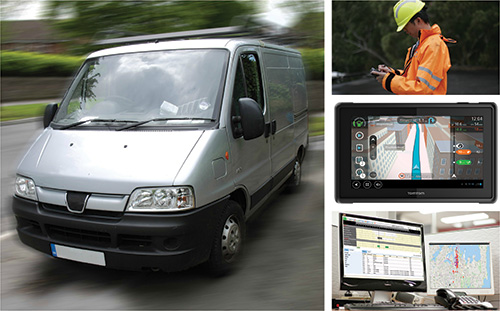It's no secret, the implementation of new technologies in any enterprise is no easy task, and utilities industry is no exception, especially when it comes to fleet management and mobile tech.
To complicate matters further, there are a few barriers that separate the first thought of implementation from the actual execution.
One reason is lack of credible and consistent information about the differences in various features and feature sets in mobile platforms, software and hardware. Additionally, not enough attention is paid to objectively discussing how operating systems affect the mobile workforce experience in the field.
Another is the overuse of industry terminology. Despite the availability of dozens of mobile enterprise products and services, one still needs a dictionary to translate engineer English' into plain English, or any other language for that matter.
Then there are the one-trick ponies, the one-feature solutions that fail to support the complete work cycle or integrate into other software products well. Go with one of these and, instead of more efficient operations you got yourself a headache.
As a result, many utility companies shy away from taking the plunge into mobile automation, instead observing from the sidelines while still depending on dinosaur manual data input processes to manage fleets. All this despite the availability of automated mobile applications designed specifically for field force.
But all that might change.
We are approaching a transformation, with several trends altering the direction for the utility industry. Among them are:
- Limited resources
- Increasing power demands
- Carbon footprint reduction requirements
- Increasing security risks
- Greater deployments of smart metering systems and smart grids
- Increased fines for service interruptions
In the last couple of years, we've observed an overall industry push to increase productivity, ensure fleet driver safety and transparency and, of course, to reduce costs associated with fleet operations.
These developments bring about a new perspective but also put pressure on operations and fleet managers to automate fleet management.

Successful implementations of mobile strategies have shown concrete and measurable results for the field technician level, as well as for the managers. Mobile solutions are as strategic as they are tactical: Capable of shortening sales and service cycles, reducing power outages, improving quality of work and increasing overall revenues. ROI is a critical factor in any business purchasing decision. According to a 2008 study by industry research firm Aberdeen Group, the average ROI associated with fleet automation includes:
- 28 percent improvement in fleet utilization
- 27 - 42 percent improvement in work order completion
- 9 - 23 percent reduction in vehicle maintenance costs
- $1055 in fuel savings per vehicle, per year
At Retriever, we recognize the need for a comprehensive end-to-end mobile-based platform that addresses the priorities of fleet managers and field technicians: Giving real-time updates on vehicles, techs, activities-in-progress and service calls to help increase employee productivity and reduce costs associated with manually performed procedures.
To combine this mobile automation expertise with the most innovative technologies in GPS-based telematics systems, we formed an alliance with LoJack, an undisputed leader in vehicle recovery and tracking.
The collaboration produced a new mobile field service management platform that provides enterprise and utility fleets with a scalable mobile solution that integrates telematics and fleet management with dynamic data capture and real time scheduling.
Until now, the enterprise didn't have access to a comprehensive mobility solution that could combine wide-ranging mobile workflow functionality with specialized fleet management and telematics. Thanks to the this relationship, field service enterprises can now implement an end-to-end solution that sends and receives data while managing and tracking field workers and commercial fleet vehicles.
Unlike competing single function offerings, the solution creates a comprehensive mobile workforce platform that caters to a variety of operational needs, from simple to complex workflows. The solution creates a new standard for the field service market by offering a complete and connected mobile force ecosystem.
Decision-making and knowledge sharing
On the strategic level, the platform improves field technician and operator decision-making by putting the latest and most accurate information at their fingertips. The data spans across business processes, from outstanding and in-progress work orders to technician status updates. Field operators can track vehicles in real-time, monitor traffic, review current orders and receive automatic notifications as their status changes so the techs in the field can be updated.

Additionally, the mobile platform supports all field force procedures needed to complete work orders and field tickets, such as parts inventory, labor and time allocation, job procedure tracking, asset tasking, site history reviews and safety management. Trip reports, fuel consumption, order and maintenance reports - all available in real-time, contribute to more accurate and confident decision-making.
Data collection in the field
In any industry these days, data collection is crucial. The platform facilitates on-site data collection, improving accuracy, eliminating paperwork and increasing workforce accountability while minimizing expenses.
Collecting information digitally, instead of using paper-based reporting, also makes information more secure and easier to track.
Efficiency
A top priority for utility companies is increasing efficiency across the board, from operations and fleet and field force management to environmental conservation. The Retriever / LoJack platform does just this by providing insight into a vehicle's trip details, including routes, idling times and stops. These details ensure the fastest response by dispatching the nearest field worker to the jobsite, eliminating after hours or weekend vehicle use while reducing carbon footprints through decreased fuel use.
The new offering allows utilities companies to integrate a complete fleet management solution into their overall field service program, bypassing extensive customization phases by using the app's built-in pre-configuration. The software integrates with a company's back office ERP system, facilitating immediate work-order distribution and condensed service cycles by enabling real-time job approvals with digital signatures.
Transparency and safety in the field
Designed around critical field force operator needs, such as 360 visibility and transparency, vehicle protection and driver safety, the platform tracks driver habits to identify and correct dangerous driving. Improved driver behavior reduces fuel and repair costs associated with servicing the fleet. Fuel consumption and maintenance bills make up nearly 30 percent1 of the total cost of operating each vehicle in your fleet. Both factors are affected by driving style.
A 2010 studies by Frost & Sullivan demonstrated that changing driving style alone could reduce fuel consumption by up to eight percent.2 Prolonged idling, constant revving of the engine and harsh braking all contribute significantly to reduced fuel economy, and all these driving styles can be modified. It is for this reason the new platform facilitates managers and drivers to monitor and then modify their driving style to curb excessive fuel usage.
Anywhere, anytime, on any device
In any industry, time is money. A mobile platform that fails to perform in areas of limited connectivity wastes both. Built with real-world environmental circumstances taken into consideration, the platform allows fleet operators to operate in limited and zero wireless coverage areas, in addition to 3G, 4G and WIFI environments.
The platform can integrate with any operating system, working on any mobile device supporting Android, iOS or Windows. It also supports mixed device' deployments and integrates with any back office system, including: Maximo, SAP, Oracle, SAGE, Kronos, Home Grown, Microsoft GP, and QuickBooks through Web Services, HTTP/s, and FTP.
Simply put, this latest collaboration offers a holistic IT approach to field service, improving cost savings by streamlining paperless internal business processes. Ushering in a different approach and philosophy to field force management and service, the platform facilitates the elimination of information silos and encourages collaboration and transparency.
Predictably, socio-economic, technological and regulatory trends are pointing in the direction of automating field force and fleet management. And, if the transition is unavoidable, then moving to a mobile-based platform isn't taking a huge leap of faith after all.
About the Author
 Mary Brittain-White is CEO of Retriever Communications. After 20 years in the wireless data industry, of which 16 years are with Retriever, Mary Brittain-White has established herself as a thought leader in the area of wireless field automation. Prior to founding Retriever, she worked for a Silicon Valley based Motorola subsidiary, RadioMail, which pioneered wireless email. From University, she joined IBM and over a 14 year career there held Sales and Marketing executive management roles. She has a Bachelor of Economics from Sydney University and a post graduate Executive Development program from Melbourne University.
Mary Brittain-White is CEO of Retriever Communications. After 20 years in the wireless data industry, of which 16 years are with Retriever, Mary Brittain-White has established herself as a thought leader in the area of wireless field automation. Prior to founding Retriever, she worked for a Silicon Valley based Motorola subsidiary, RadioMail, which pioneered wireless email. From University, she joined IBM and over a 14 year career there held Sales and Marketing executive management roles. She has a Bachelor of Economics from Sydney University and a post graduate Executive Development program from Melbourne University.
References
1 Athlon Car Lease, total cost of ownership average values, February 2011.
2 Frost & Sullivan, Essential European Fleet Management, February 2010.








